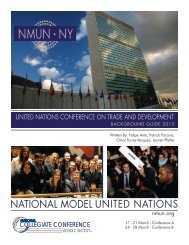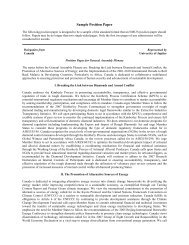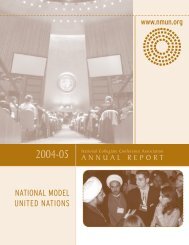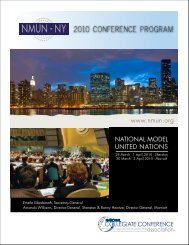UNFPA Background Guide - National Model United Nations
UNFPA Background Guide - National Model United Nations
UNFPA Background Guide - National Model United Nations
Create successful ePaper yourself
Turn your PDF publications into a flip-book with our unique Google optimized e-Paper software.
operational strategies of each fund remain consistent with overall policy; (d) monitor the performance of the<br />
program; (e) approve projects; (f) decide on administrative and financial budgets; (g) recommend new initiatives; (h)<br />
encourage and examine new program initiatives; and (i) submit annual reports to the Council at its substantive<br />
session. 29<br />
Recent Sessions<br />
A number of recent <strong>United</strong> <strong>Nations</strong> Population Fund projects correlate to the mandate. In the 2012 session, <strong>UNFPA</strong><br />
focused on the preparation of 7 billion individuals on the globe, expand access to maternal and newborn health, and<br />
strengthen HIV prevention, gender equality, urbanization, and migration. 30 For example, <strong>UNFPA</strong> understands 2,400<br />
young individuals are infected with HIV every day, and because the world’s youth lack knowledge on HIV<br />
prevention, the <strong>United</strong> <strong>Nations</strong> Population Fund has supported networks such as YouthForce. 31 YouthForce<br />
combines youth organizations to collaborate and keep youth issues at the forefront of the International AIDS<br />
agenda. 32 In 2012, UNDP and <strong>UNFPA</strong> have continued to strengthen joint assessments, analyses, and design<br />
programs, which have built resilience to better prepare for and recover from social, economic, and political shocks. 33<br />
Compared to the previous strategic plan with three goals: increasing gender equality, universal access to<br />
reproductive health, universal access to HIV medication, and advanced women gender equality, the 2013 revised<br />
version has one goal of achieving universal access to sexual reproductive health with seven outcomes. 34 In 2012, on<br />
behalf of the UN, <strong>UNFPA</strong> established a secretariat to lead a global review of progress towards achieving the ICPD<br />
Programme of Action. 35 Furthermore, <strong>UNFPA</strong> developed a business plan with seven key action points: focused<br />
programming, field support and focus, communication, staff skill-building and empowerment, streamlining of<br />
management and operations, breaking organizational silos, and holding senior management accountable. 36 The Fund<br />
has developed the 2014-2017 strategic plan to: strengthen medium-term to long-term strategic planning on the<br />
country level, better define operational implications to target the needs of women, improve staff and organizational<br />
capacity in maternal health, provide better evaluation at the country level, and increase the focus on the generation<br />
of knowledge and learning. 37<br />
Conclusion<br />
One-quarter of the world’s population is between the ages of 10-24 years old, allowing <strong>UNFPA</strong> to promote and<br />
protect the rights of this generation. 38 The <strong>United</strong> <strong>Nations</strong> Population Fund plays a vital role in addressing<br />
population issues, further attaining the MDGs while it stresses the correlation between gender, culture, and human<br />
rights. 39 Member States and international organizations have to recognize the struggle and difficult decision to<br />
balance national sovereignty and moral ethics. 40 The international community will continue to grow, and there are<br />
many humanitarian rights and other issues <strong>UNFPA</strong> has to deal with, as broad as policy reforms, or field level<br />
programs monitoring. 41 Member States and international organizations must continuously coordinate, implement,<br />
and structure humanitarian assistance in order to fulfill the mandate and achieve the goals set by <strong>UNFPA</strong>.<br />
29<br />
UN General Assembly, Further Measures for the Restructuring and Revitalizing of the <strong>United</strong> <strong>Nations</strong> in the Economic,<br />
Social, and Related Fields (A/48/162) [Resolution], 1994.<br />
30<br />
<strong>UNFPA</strong>, Delivering Results in a World of 7 Billion [Report], 2012.<br />
31<br />
Ibid., 2012.<br />
32<br />
<strong>UNFPA</strong>, Promises to Keep [Report], 2012.<br />
33<br />
<strong>UNFPA</strong>, Report to the Economic and Social Council (E/2013/5) [Website], 2013.<br />
34<br />
<strong>UNFPA</strong>, Cumulative Analysis of Progress in Implementation of the <strong>UNFPA</strong> Strategic Plan 2008-2013, (DP/FPA/2013/3),<br />
2013, p. 6.<br />
35<br />
<strong>UNFPA</strong>, Promises to Keep [Website], 2013.<br />
36<br />
<strong>UNFPA</strong>, <strong>UNFPA</strong> - New Strategic Direction [Website], 2013.<br />
37<br />
UNDP, Decisions adopted by the Executive Board at its first regular session 2013 (DP/2013/10), 2013, p. 4.<br />
38<br />
<strong>UNFPA</strong>, About <strong>UNFPA</strong> [Website], 2013.<br />
39<br />
<strong>UNFPA</strong>, The Foundation for <strong>UNFPA</strong>’s Work [Website], 2013.<br />
40<br />
<strong>UNFPA</strong>, Summary of the ICPD Programme of Action [Website], 2013.<br />
41<br />
Sadik, Making a Difference: Twenty-five Years of <strong>UNFPA</strong> Experience [Website], 2013.<br />
7









